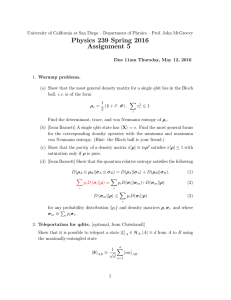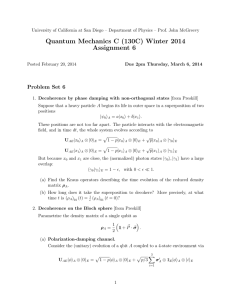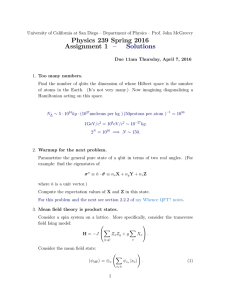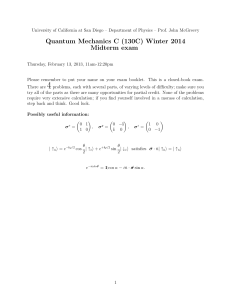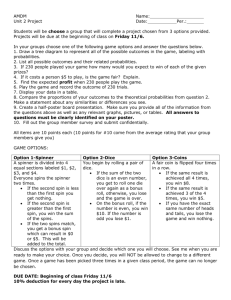Quantum Mechanics C (Physics 130C) Winter 2015 Assignment 7
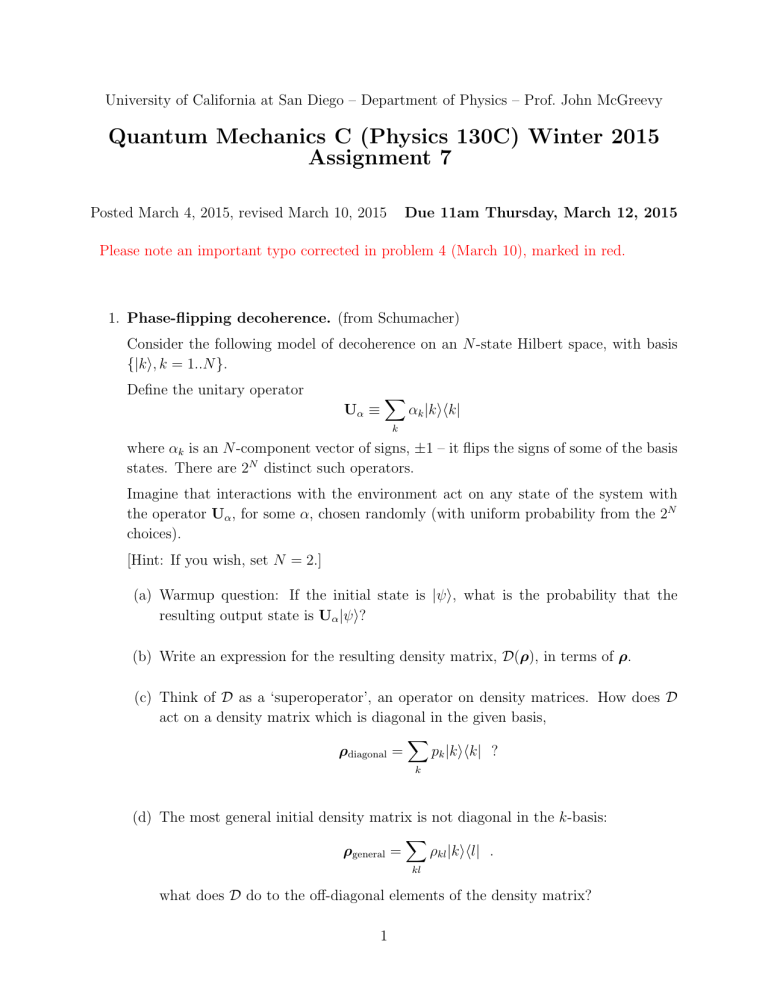
University of California at San Diego – Department of Physics – Prof. John McGreevy
Quantum Mechanics C (Physics 130C) Winter 2015
Assignment 7
Posted March 4, 2015, revised March 10, 2015 Due 11am Thursday, March 12, 2015
Please note an important typo corrected in problem 4 (March 10), marked in red.
1.
Phase-flipping decoherence.
(from Schumacher)
Consider the following model of decoherence on an N -state Hilbert space, with basis
{| k i , k = 1 ..N
} .
Define the unitary operator
U
α
≡
X
α k
| k ih k | k where α k is an N -component vector of signs, states. There are 2 N distinct such operators.
± 1 – it flips the signs of some of the basis
Imagine that interactions with the environment act on any state of the system with the operator U
α
, for some α , chosen randomly (with uniform probability from the 2 N choices).
[Hint: If you wish, set N = 2.]
(a) Warmup question: If the initial state is | ψ i , what is the probability that the resulting output state is U
α
| ψ i ?
(b) Write an expression for the resulting density matrix, D ( ρ ), in terms of ρ .
(c) Think of D as a ‘superoperator’, an operator on density matrices. How does D act on a density matrix which is diagonal in the given basis,
ρ diagonal
=
X p k
| k ih k | ?
k
(d) The most general initial density matrix is not diagonal in the k -basis:
ρ general
=
X
ρ kl
| k ih l | .
kl what does D do to the off-diagonal elements of the density matrix?
1
2.
Decoherence by phase damping with non-orthogonal states [from Preskill]
[extra credit]
Suppose that a heavy particle A begins its life in outer space in a superposition of two positions
| ψ
0 i
A
= a | x
0 i + b | x
1 i .
These positions are not too far apart. The particle interacts with the electromagnetic field, and in time dt , the whole system evolves according to
U
AE
| x
0 i
A
⊗ | 0 i
E
U
AE
| x
1 i
A
⊗ | 0 i
E
= p
1 − p | x
0 i
A
⊗ | 0 i
E
+
√ p | x
0 i
A
⊗ | γ
0 i
E
= p
1 − p | x
1 i
A
⊗ | 0 i
E
+
√ p | x
1 i
A
⊗ | γ
1 i
E
But because x
0 overlap: and x
1 are close, the (normalized) photon states | γ
0 i , | γ
1 i have a large h γ
0
| γ
1 i
E
= 1 − , with 0 < 1 .
(a) Find the Kraus operators describing the time evolution of the reduced density matrix ρ
A
.
(b) How long does it take the superposition to decohere? More precisely, at what time t is ( ρ
A
)
01
( t ) =
1 e
( ρ
A
)
01
( t = 0)?
3.
Decoherence on the Bloch sphere [from Preskill]
Parametrize the density matrix of a single qubit as
ρ
A
=
1
2
1 +
~
· σ .
(a) Polarization-damping channel.
Consider the (unitary) evolution of a qbit A coupled to a 4-state environment via
U
AE
| φ i
A
⊗ | 0 i
E
= p
1 − p | φ i
A
⊗ | 0 i
E
+ p p/ 3
3
X
σ i
A
⊗ 1
E
| φ i
A
⊗ | i i
E i =1
Show that this evolution can be accomplished with the Kraus operators
M
0
= p
1 − p 1 , M i
= p p/ 3 σ i
, and show that they obey the completeness relation requred by unitarity of U
AE
.
Show that the polarization P i of the qbit evolves according to
~ → 1 −
4 p
3
[Hint: use the identity σ i
σ j
σ i
= 2 σ j
δ ij
− σ j
.]
Describe this evolution in terms of what happens to the Bloch ball.
What happens if p > 3 / 4?
2
(b) Two-Pauli channel.
[extra credit]
Consider the (unitary) evolution of a qbit A coupled to a three -state environment via
U
AE
| φ i
A
⊗ | 0 i
E
= p
1 − p | φ i
A
⊗ | 0 i
E
+ p p/ 2
2
X
σ i
A
⊗ 1
E
| φ i
A
⊗ | i i
E i =1
Show that this evolution can be accomplished with the Kraus operators
M
0
= p
1 − p 1 , M i
= p p/ 2 σ i
, i = 1 , 2 and show that they obey the completeness relation requred by unitarity of U
AE
.
Describe this evolution in terms of what happens to the Bloch ball.
(c) Phase-damping channel.
[extra credit]
For the evolution of problem
U
AE
| 0 i
A
⊗ | 0 i
E
= p
1 − p | 0 i
A
⊗ | 0 i
E
+
√ p | 0 i
A
⊗ | γ
0 i
E
U
AE
| 1 i
A
⊗ | 0 i
E
= p
1 − p | 1 i
A
⊗ | 0 i
E
+
√ p | 1 i
A
⊗ | γ
1 i
E now thinking of A as a qbit, describe the evolution of its polarization vector on the Bloch ball.
4.
Near-derivation of Born rule
This question is about a step in Hartle’s near-derivation of the Born rule. We studied the Hilbert space of N copies of our system, H ⊗ H · · · ⊗ H = H N
, and the state
| c i ≡
X n
1
..n
N c n
1
· · · c n
N e i P i ϕ i,ni | n
1
· · · n
N i ≡
X
ν
Y c
N
νn n n
!
e i ϕ
ν | ν i where we introduced the shorthand ν ≡ { n
1
· · · n
N
} and N
νn of the set ν equal to n . Notice that for each ν P n
N
νn
= N .
is the number of elements
We defined the hermitian ‘frequency’ operators P n by their eigenvalue equation:
P n
| ν i =
N
νn
| ν i .
N
Show that
|| P n
− | c n
| 2 | c i || 2
=
1
N
| c n
| 2
1 − | c n
| 2 ≤
1
4 N
.
Hints:
3
• For any fixed N n
, the number of ν s with N
νn
= N n is
N !
N
1
!
N
2
!
· · ·
.
• h ν
0 | ν i = δ
νν
0
• The multinomial theorem says
X
| c m
| 2
!
N m
=
X
N
1
,N
2
...
| P n
N n
= N
N !
N
1
!
N
2
!
· · ·
Y
| c m
| 2 N m m
• Differentiating the BHS of the previous equation with respect to | c m
| 2 acting with | c m
| 2 ∂
∂ | c m
| 2
) gives a formula for
(or better,
X
N
1
,N
2
...
| P n
N n
= N
N !
N
1
!
N
2
!
· · ·
Y
| c m
|
2 N m N n m
5.
Two coupled spins.
[based on Le Bellac problem 6.5.4]
Consider a four-state system consisting of two qbits,
H = span {|
1 i ⊗ |
2 i ≡ |
1 2 i , = ↑ z
, ↓ z
} .
(a) For each qbit, define σ
± tors for σ z : [ σ z , σ
±
≡ 1
( σ x ± i σ y ). (These are raising and lowering opera-
] = ± 2 σ
2
±
. Show this.) Show that
~
1
· σ
2
= 2 σ
+
1
σ
2
−
+ σ
−
1
σ
2
+
+ σ z
1
σ z
2
.
(b) Determine the action of the operator ~
1
· ~
2 on the basis states
| ↑↑i , | ↑↓i , | ↓↑i , | ↓↓i .
(c) Show that the four vectors
| 0 , 0 i =
1
√
2
( | ↑↓i − | ↓↑i ) , | 1 , 1 i ≡ | ↑↑i , | 1 , 0 i ≡
1
√
2
( | ↑↓i + | ↓↑i ) , | 1 , − 1 i ≡ | ↓↓i are orthonormal and are eigenvectors of ~
1
· ~
2 with eigenvalues 1 or − 3.
(d) Show that they are also eigenvectors of J
2 find their eigenvalues.
≡ ( ~
1
+ ~
2
)
2 and J z ≡ σ z
1
+ σ z
2 and
(e) Consider the operator
P
1 , 2
≡
1
(1 + ~
1
2 acting on the two spins. Show that P
1 , 2
· ~
2
) acts by exchanging the states of the two spins:
P
1 , 2
|
1 2 i = |
2 1 i .
4
6.
Coherent states.
Consider a quantum harmonic oscillator. The creation and annihilation operators a
† and a satisfy the algebra
[ a , a
†
] = 1 and the vacuum state | 0 i satisfies a | 0 i = 0 .
Coherent states are eigenstates of the annihilation operator: a | α i = α | α i .
(a) Show that
| α i = e
−| α | 2
/ 2 e
α a
†
| 0 i = e
−| α | 2
/ 2
∞
X
α n
√ n !
| n i n =0 is an eigenstate of a with eigenvalue α . ( a is not hermitian, so its eigenvalues need not be real.)
(b) Coherent states with different α are not orthogonal. ( a is not hermitian, so its eigenstates need not be orthogonal.) Show that |h α
1
| α
2 i| 2 = e
−| α
1
− α
2
|
2
.
(c) Compute the expectation value of the number operator n = a
† a in the coherent state | α i .
(d) Time evolution acts nicely on coherent states. The hamiltonian is H =
~
ω a
† a +
Show that a coherent state evolves into a coherent state with an eigenvalue α ( t ):
1
2
.
e
− iH t | α i = e
− i ωt/ 2 | α ( t ) i where α ( t ) = e
− i ωt α .
7.
Spin chains and spin waves.
[Related to Le Bellac problem 6.5.5 on page 200]
A one-dimensional ferromagnet can be represented as a chain of N qbits (spin-1 / 2 particles) numbered n = 0 , ...N
− 1 , N 1, fixed along a line with a spacing ` between each successive pair. It is convenient to use periodic boundary conditions (as in HW 2 problem 2), where the N th spin is identified with the 0th spin: n + N ≡ n . Suppose that each spin interacts only with its two nearest neighbors, so the Hamiltonian can be written as
H =
1
2
N J 1 −
1
2
J
N − 1
X n =0 n
· ~ n +1
.
where J is a coupling constant determining the strength of the interactions.
(a) Show that all eigenvalues E of H are non-negative, and that the minimum energy
E
0
(the ground state ) is obtained in the state where all the spins point in the same direction. A possible choice for the ground state | Φ
0 i is then
| Φ
0 i = | ↑ z i n =0
⊗ | ↑ z i n =1
⊗ ...
⊗ | ↑ z i
N − 1
≡ | ↑↑ ...
↑i .
5
(b) Show that any state obtained from | Φ
0 i by rotating each of the spins by the same angle is also a possible ground state.
[Hint: the generator of spin rotations
~
≡ P n nian.] n commutes with the Hamilto-
[Cultural remark: the phenomenon of a ground state which does not preserve a symmetry of the Hamiltonian is called spontaneous symmetry breaking . ]
(c) Now we wish to find the low-energy excitations above the ground state | Φ
0 i . Show that H can be written
H = N J 1 − J
N − 1
X
P n,n +1
= J
N − 1
X
(1 − P n,n +1
) .
n =0 n =0 where
P n,n +1
≡
1
2
(1 + ~ n
· ~ n +1
) .
Using the result of the previous problem, show that the eigenvectors of H are linear combinations of vectors in which the number of up spins minus the number of down spins is fixed. Let | Ψ n i be the state in which the spin n is down with all the other spins up. What is the action of H on | Ψ n i ?
(d) We are going to construct eigenvectors | k s i of H out of linear combinations of the
| Ψ n i . Let
| k s i =
N − 1
X e i k s n` | Ψ n i n =0 with k s
=
2 πs
, s = 0 , 1 , ...N
− 1 .
N `
Show that | k s i is an eigenvector of H and determine the energy eigenvalue E k
.
Show that the energy is proportional to k
2 s as k s
→ 0. This state describes an elementary excitation called a spin wave or magnon with wave-vector k s
.
6

